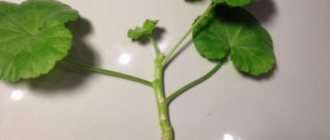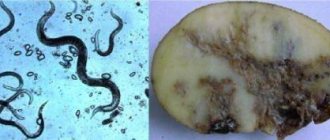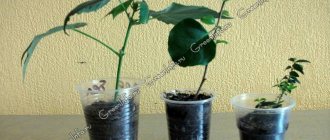As is known, the rapid formation of roots contributes to better rooting of cuttings. You can always find special root formation stimulants on sale. However, expensive drugs can be easily replaced with simple products that are always at hand.
Not all plants are able to quickly form roots; some plant cuttings take too long to develop roots. If we want to speed up this process, we need to help the plant, push it to form roots. We want to tell you about popular folk methods of stimulating root formation, tested from our own experience by more than a dozen summer residents.
Rooting cuttings in aloe juice
The benefits of aloe vera (in our country this plant is better known as agave) for humans is a well-known fact. Thanks to the beneficial substances and vitamins it contains, it has a restorative and healing effect on the human body. Aloe can bring no less benefit to plants, improving their root formation. It is believed that the maximum effect comes from the juice of plants that are at least 3 years old, so for stimulation, take the lower - more mature - leaves and carefully cut them with a knife.
After cutting, wrap the leaves in a plastic bag and place them in the refrigerator for several hours. Under the influence of low temperature, the formation of biologically active substances begins in the leaves - the beneficial effect of aloe is enhanced.
After this, squeeze the juice out of the agave and add 5-7 drops to a glass of water. Leave the cuttings in the resulting solution for 2 days. After this time, transplant them into the ground.
Green cuttings
As stated above, green cuttings are the rooting of a “green” shoot, that is, a still vegetative and immature shoot. The cuttings contain very few nutrients and plastic substances, and therefore for successful rooting it is necessary to have leaves on the shoot. It is thanks to the presence of a leaf (or part of it) that the process of root formation occurs. But the leaf evaporates a lot of moisture, and given the large amount of time required for rooting (usually up to 2-4 weeks before the first roots appear), the leaf must be constantly moistened and ensure constant humidity not only for the substrate, but also for the surrounding air. Therefore, rooting is carried out in special greenhouses with regular irrigation or greenhouses with artificial fogging. We have several publications on green rooting on our website; to view them you need to follow the link.
Rooting cuttings in honey
Honey has many beneficial properties, which are used not only to treat people, but also to stimulate root formation in plants.
To obtain a natural stimulant, dissolve 1 tsp. honey in 1.5 liters of warm water. The water temperature should not exceed 40°C, otherwise the beneficial properties of the sweet product will be destroyed. Place the cuttings in the prepared solution for half a day, and then transfer them to a container with clean water or plant them in the ground. Thanks to honey stimulation, the roots of the cuttings will appear much earlier.
Rooting stimulants
Some crops do not require stimulants, but most give a much higher percentage of rooting and a more powerful root system, as well as growth when using stimulants for root formation. As a rule, these are various auxins: the most effective of them is IBA (indolylbutyric acid). But complex products made from IMC or, for example, indolylacetic acid, mixed with vitamins and fungicides, as well as inert substances, are often used. For example, the English Clonex Gel, like the Russian Phytoklon, are supplied in the form of a thick gel that contains IMC and additives. When a cut of a cutting is dipped into the gel, it quickly and tightly envelops the cut and protects it from fungal infections.
Finally, it is worth adding that different crops are cut in very different ways. Tree crops take cuttings the worst, but various vines and herbaceous perennials, on the contrary, are usually rooted by cuttings quite successfully. Cuttings from young plants usually root better than those from old ones. Within one species there can be a very large variation - from 80-100% rooting to a complete inability to form roots from cuttings.
Plant cuttings are a very exciting process and a great way to propagate existing plants for your own collection or for friends, but it is also a very popular method of plant propagation for industrial growing.
Rooting cuttings in willow water
It would seem, how can willow help cuttings and speed up root formation? The reason is that willow bark contains salicin, a natural compound from which salicylic acid was first obtained. For plants, this substance is a natural phytohormone that can increase seed germination and accelerate root formation of cuttings.
To obtain a natural stimulant from willow, cut young shoots of the tree and place them in water. After roots appear on the branches, remove the willow from the container and place the cuttings there instead. If necessary, add clean water and mix it with the willow.
In the inner layer of poplar bark, just like in willow, salicin is present. For this reason, the effect exerted on cuttings by poplar and willow is very similar. Take young poplar branches, cut them into 7-8 cm pieces and pour boiling water over them. Place in a dark place for 12 hours to allow the solution to infuse, and then strain it. Place the cuttings into the resulting root formation stimulator.
Root cuttings
As the name of the method suggests, pieces of roots are cut, usually containing shoot buds. Crops that naturally reproduce by root shoots are often propagated this way. Thus, root cuttings are the traditional and most effective way to propagate raspberries. Pre-harvested roots are sorted, cut into pieces and early in the spring laid out on a moist substrate for germination. Then parts of the roots with emerging seedlings are planted in cassettes for growing.
The reproduction rate of this method is very high. Another alternative to this method can be considered digging up the emerging growth, that is, separating the shoot that has emerged from the soil with part of the root.
Rooting cuttings in egg white
Take one egg white and fill it with 200 ml of warm water. Let it sit for a week, then dilute it with water in a ratio of 1:2 (protein:water) and pour the solution over the cuttings planted in the ground. If necessary, watering can be repeated.
Not all summer residents are ready to try this method of improving the root formation of cuttings because of the far from pleasant smell that appears after the protein has been infused for several days.
Which means of stimulating root formation do you prefer – store-bought or natural?
Nuances and features common to all types of cuttings
For any type of cuttings, general recommendations must be followed. So, the main problem is various fungal infections, such as root rot. As long as there are no roots, the open cut is a “gateway” for infection. In this regard, it is necessary to maintain cleanliness, disinfect the substrate, dishes and cutting tools. If signs of infection appear (or for prevention), use fungicides.
The vast majority of crops need air in the root formation zone; rarely are any species capable of rooting “in a glass of water,” although the most unpretentious ones take root this way, for example, a willow branch, the same Saintpaulia, etc.
How to take mock orange cuttings
Mock orange reproduces well by unusually large cuttings: in spring or autumn, cut shoots up to half a meter high are simply stuck into moist soil next to mock orange, currants or other plants that provide a lacy shadow.
Sodmaster
After a year, the young plants are ready for planting in a permanent place.
What plants are propagated from green cuttings?
The question of whether it is possible to propagate a particular plant from cuttings is primarily of concern to novice gardeners. Indeed, not every plant lends itself easily to vegetative propagation.
This depends on the ability of the perennial to quickly form adventitious roots. Green cuttings of the following popular ornamental crops will take root more or less well:
|
|
Plant cuttings: sequence of actions
The process of cuttings or cloning your green pets is carried out in the following order:
- We sterilize a knife, scalpel or pruning shears, that is, those instruments that will be in direct contact with the cuttings.
- We prepare the growing medium: you can take mineral wool, moisten it with a buffer solution (this will help remove excess alkali from this material) and squeeze it lightly to prevent excess nutrients.
- Select a donor. The mother plant should not be sick or bloom.
- Cut a side branch with at least three internodes.
- Use a scalpel to prepare the clones. So, you need to remove the bottom pair of leaves to avoid rotting, and just below the last internode a cut is made at an angle of 45.
- If the plant has large foliage, it is worth cutting the leaf blades by a third or half. This is done so that too much moisture does not evaporate through them. In addition, leaves that are too large may wither in the first days after planting.
- Cuttings should not be immediately placed into water or soil; most plants need the clones to lie in the open air for a couple of hours. Or you can place the fresh cutting in a rooting powder or gel like Hesi Clonfix, Clonex or MaxiClon.
- Immerse the clone in the prepared medium; to do this, make a hole into which the cutting should be placed approximately one-third of the way. In addition to mineral wool, you can take the Root Riot cube.
- A heated mat or transparent cap that covers the cuttings helps to increase the success of the process. This is necessary to maintain optimal temperature (21-25°C) and humidity level (80-90%).
- Spray the clones daily with water or foliar fertilizer; to water the medium, use a nutrient solution with EC 0.3-0.8 (about a third of the standard dosage). It is important to avoid overwatering and immediately remove rotten leaves.
Usually the first roots hatch within a week or a week and a half, which depends on the type and variety of the plant. After their appearance, it is necessary to gradually “accustom” the clones to future conditions. However, sudden changes in temperature, humidity, amount of lighting and nutrients should not be allowed, otherwise the cuttings may die.
If we talk about the optimal moment for preparing clones, then the lunar calendar for plant cuttings will come to the rescue. The most favorable time for this procedure is at the junction between the first and second phases of the moon, that is, from the 6th to the 9th lunar day.
How to take forsythia cuttings
Semi-lignified green cuttings of forsythia are cut in June. Before planting them in wet sand, it makes sense to dip them in horseweed. Cuttings will root quickly if you keep the soil moist at all times.
Sveta2609
In May-June, you can bend the lower young branch to the ground, secure it with wire and sprinkle it with fertile soil - roots will quickly form on it, and in the spring, cut this branch from the bush. Next year flowers will appear on the new plant.
At FORUMHOUSE you can get acquainted with the experience of our users in cuttings from various plants, watch a video about winter cuttings, read an article on how to properly cut grapes.
How to cut girlish grapes
Cuttings of maiden grapes are cut before the sap begins to flow from young shoots (up to four years), but woody shoots take root best when they are one year old. The size of the cutting should be 25 -35 cm, and there should be 3-4 buds on it. The cuttings are planted in well-dug, light, loose soil to a depth of about 20 centimeters.
Strawberry Month FORUMHOUSE Member
I cut it with three eyes. I placed the cuttings in a jar of water. They stood there for about a month. I changed the water as needed. White convex dots, future roots, appeared on the cuttings, and in May the cuttings were buried in moist soil, in the shade. I buried it in one eye. After about a month, the cuttings took root and began to grow.
How to take lilac cuttings
Lilac cuttings take root quite difficult; this crop is easier to propagate by budding. However, this is possible if you cut the cuttings at a time when the lilac is just beginning to bloom, subject to high humidity and a temperature of +23-25 degrees.
Sodmaster
Some varieties (Jeanne d'Arc, Buffon, etc.) take root well. Others (for example, Beauty of Moscow) are very difficult, and most importantly, for a long time, sometimes right up to the next year after cuttings.











